|
The
peasant's reality
|
Till the end of the 60’s, the village lived on a rural
reality based on the little property, only a few families
had big estates (“i particular”).
The tilling
of the land, the only source of profit for the main part
of the inhabitants, was done thanks to the use of oxen and
horses. During the harvest time that is to say: the reaping
time, the grape harvest, the haymaking and the corn harvest,
there were also moments of aggregation. People tried to
help each others as there was a great need of labour with
a great sense of cooperation. |
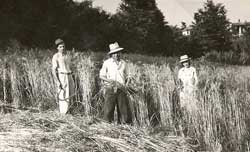
the harvest time at Villa Morbelli - 1948
|
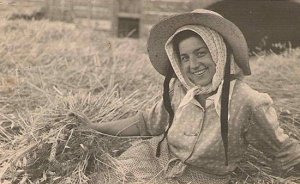
"Amson" (the
harvest time)
The threshing
The threshing foresaw that all the families were engaged
for several days in helping each others. The threshing machine
started its job in a farm and then moved to the following,
day by day, from farm to farm; each member of the family
played a special role around the machine. Finally, in the
evening, men debated on the quality and quantity of the
corn: “this one is the best, though that one is plentiful…”,
“should it had not hailed…”. Soon after,
the threshing machine left the village, leaving barns more
or less full, haylofts full of hail and a lot of dust.
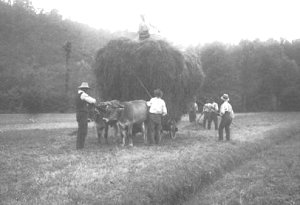 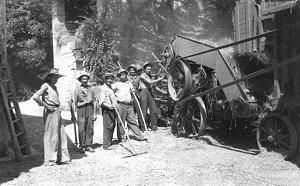
the hay time
- The threshing machine
The broad bean harvest
The growing of broad beans, together with the hail, constituted
the feed for the cattle during the winter season and, in
the meanwhile, enriched the soil with organic elements.
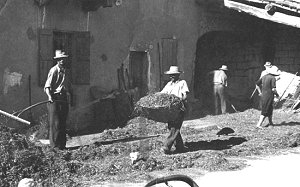
The broad bean harvest
After the harvest, end of June, in the courtyards there
was the drying up phase, then there was the period of threshing
phase made with specific tools: “al tresc”,
for example, was a farm tool made up by two sticks united
by a string of leather. The peasants used it by holding
one of the sticks and rotating the other which hit the pods
still closed and attached to the plant, in a manner to free
the plant from its seeds. At the end of the threshing time,
with the “val”, they cleaned the seeds from
the remaining of the pods.
The grape and maize harvest
Since September, men started putting in order again the
basements. They washed the barrels, the tubs and the bins,
these latest were loaded on barrows and tightly tied. They
prepared the scissors, the tins, the stairs, the wine casks
and everything which was necessary for these kind of activities.
Peasants scanned the horizon hoping for the sun, then one
morning they left. On the hillsides there was a great animation,
families and friends were all involved in the event. Yet,
only a few big farms could afford the recruiting of labour
by paying them.
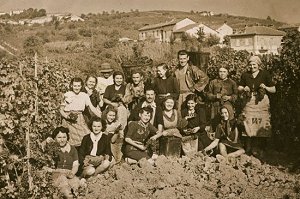
grape harvest on the hill ( "bric")
Teams of grape-gatherers sung and on the
other side of the hill others answered. The grape harvest
finished, in the courtyards arrived the maize harvested:
the barrows unloaded lots of maize-cobs and in the evenings
everybody had to (“snuvia la meglia”) to husk
the maize. Everybody sat on the heaps of maize, chatted
and in the meantime often sung and stripped the maize-cobs,
that once cleaned were thrown near the wall of the house,
where they stayed for a period in order to dry up: the wastes,
constituted by leaves, formed in a corner big, soft cobs,
and children could dive for the whole evening. The following
day, the same thing would happen in another courtyard. The
extended agricultural mechanisation arrived in the ‘60s:
the ancient barrows were abandoned and they remain the only
witnesses of this glorious past full of hard work.
The mining of cornerstones
from the mines
The hill of the Colma has in its subsoil the cornerstone
("Pietra da Cantoni"),
better (and improperly) known as "tuff": it is a fine grain, tender and friable
marl and marly sandstone.
These marine rocks deposited, 15-20 millions years
ago, at a relatively shallow sea depths. This sea occupied
most of the Monferrato area; as
a matter of fact, it is not difficult to find fossil shells or
fish teeth in the blocks, used during
the building up of the houses.
Many mines were opened;
inside there the layer of "tuff"
had a thickness of about 10 m and followed the outline
of the hill; for centuries these mines supplied with
building
materials. The mines were formed by tunnels 5 m width
, with a height of 5 m too. From the main gallery departed,
perpendicularly, entry tunnels and other galleries which
were parallel to the main one.
The galleries bays were 5 m width and between a digging
out and the other there was another space left 5 m
width too. The main purpose of this solution was for safety
reasons: to avoid the collapsing of the gallery. Many digging
outs, further to the extraction of the tuff, were filled
in with recovery materials deriving from the squaring of
the blocks.
|
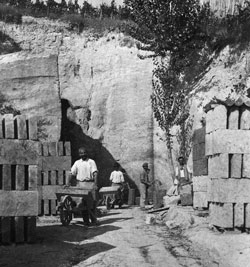
wheel
barrows out of a quarry
|
The dimensions of the blocks of squared "tuff", in vernacular
named “canton”, were 50 cm x 25 cm x 15
cm, with
a total weight of around 32 Kg.
They were used for the building
up of houses and rural residences. The dimensions of the
flat tiles (in vernacular, “pianeli”) were different, larger and higher but much thinner, with a weight of around
45Kg, used for the building up of ovens.
|
|
Some mines are
still visible, though by now neglected more than a half
of a century ago.
Many were the professional quarrymen who worked in the
digging out of the blocks of squared tuff, but many others
were also the so called “seasonal workers” who
worked in mines to provide for the needs of their families.
These latest, in addition to the hard farm work they carried
out this activity and, once mined and piled up, the
"canton"
were carried away with burrows dragged by horses.
More or less important mines were managed by the
Angelino,
Campagnola
and Valleggia families.
|
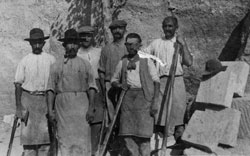
quarrymen
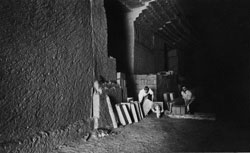
the inner
part of a quarry
|
|